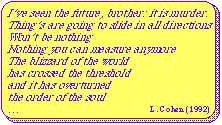
- presented at ENSEC'93, International Conference on Energy Systems and Ecology, July 5-9, 1993, Krakow, Poland. Publ. Proc., Szargut, J., et al., eds., pp. 111-121
- and presented at "2nd European Congress on Economics and Management of Energy in Industry", April 5-9, 1994, Estoril, Portugal.
Economy has failed to create and maintain social welfare - natural resources are depleted, the living environment is dying and unemployment is increasing. A dangerously unstable situation is emerging. Corruption, criminal activities and wars are spreading like viruses. The present situation is best expressed in lyrics: {Cohen 1992}

Economy is failing because it lacks connections to the real world. The crisis and its causes are better understood from a physical approach. The lack of natural resources origin from the fact that matter (or energy) can not be created or destroyed. The environmental destruction is also a direct consequence from this, since, environmental pollution starts when substances from the lithosphere - deposits - enter the society. Economy does not regard human beings as intelligent independent actors, but as predictable producers and consumers of economic values. Economy is by some even supposed to rule human behavior.
Physical resources, i.e. energy and matter, could be classified in natural flows , deposits , and funds . {Wall 1987} Today, the use of deposits in the industrialized world has reached a level never seen before, implying resource depletion and environmental destruction. In the long run, the use of physical resources in the society must depend almost entirely from renewable resources, i.e. natural flows and funds. Technical improvements often become sophisticated rather than efficient, e.g. nuclear-produced electricity used for space heating or air-conditioning, see below. By applying concepts like exergy to the societal metabolism we gain necessary knowledge and understanding, e.g. where resource use could be improved.
Energy and exergy could be expressed: (1) energy is motion or ability to produce motion and (2) exergy is work (= ordered motion) or ability to produce work. Thus, energy is most often an all too hazy concept, whereas exergy is more strict.
The exergy E of a system in a large environment is {Wall 1977}
|
|
|
|
|
|
Analogously, the exergy of a flow, i.e. open system, becomes
|
|
|
Natural resources are traditionally divided into energy and other resources. This separation is often only arbitrary, e.g. oil, is usually regarded as energy and wood as a construction material. However, oil can also be used for producing useful materials and wood can be used as a fuel. It would be more appropriate to consider these resources together and exergy is an adequate resource measure. The exergy content of energy resources may be given by their energy content multiplied by an exergy factor. (Table 1)

Similarly, materials can be quantified in exergy, e.g. by an exergy factor of unit J/m3 or J/kg. This could be the start of an expanded resource budgeting and a first step towards an integration with traditional energy accounting. Exergy is the physical value of a resource that can be compared to the economical value.
The exergy concept is mostly used within energy optimization studies, where different energy forms occur, and in ecological modeling {Herendeen 1989}. However, the field of application can be extended to the total societal metabolism. This yields a uniform description of the use of physical resources and the environmental impacts from this use.

Exergy from the contrast between the sun and space drives flows of energy and matter on the surface of the earth. (Fig. 1) {Wall 1986} When exergy reaches the earth, it is gradually destroyed, but on the way it manages to drive, among other things, the water/wind system, and life on earth. Complex structures, rich in exergy and capable of reproduction, are formed by photosynthesis in the biosphere.

In Fig. 2, we see how the exergy flow through human society is maintained. The greater part of the exergy requirements are seen to from the terrestrial exergy stocks. Man only uses a very small part of the exergy flow from the sun, e.g. within agriculture. In society there is thus, on the whole, a continuous exergy loss. Some exergy flows, such as flows of ores, increase their exergy when passing through society. However, other flows decrease their exergy all the more.
Let us exemplify the situation by the space heating system in many industrialized countries. (Fig. 3) Suppose, nuclear fuel is used in Light Water Reactors (LWR) to produce electricity. LWR-technology only extracts a small fraction of the available nuclear exergy, or 1.5%. More efficient reactors like breeders are needed to improve this. Through a steam power process about 30% of the extracted exergy become electricity that is used in short circuiting devices to produce heat at room temperature, with less than 5% efficiency. Thus, the net efficiency ends up to less than 0.25 , or 250 ppm! Of the available exergy only 1 part of 4000 is utilized, and 3999 parts are lost in the process. From a physical approach this is a disaster, but still economically and politically justified.

Of the total inflow of physical resources into industrialized
societies often less then 20% reaches final use. {Wall 1987, 1990,
Wall et al. 1992} Heavy losses could be considerably reduced by an
active resource budgeting and economizing at all levels in the
society. In particular, better insulation would decrease the need of
space heating and air-conditioning, and would also improve indoor
comfort.
Thus, exergy studies provide us with knowledge of how effective and
balanced a society is regarding physical resource use. This
information can be used to identify areas where technical and other
improvements could be undertaken, and indicate the priorities that
could be assigned to conservation measures. Making comparisons of
this type between various societies throughout the world and studying
the international system should also be of fundamental interest if we
are serious in our efforts to work towards a more equitable
distribution of resources in the world.
Let us approach ecology by asking - What am I? It is not possible to strictly define a human being, since, it constantly interacts with its environment. A continuous flow of energy and matter passes through our bodies, which during a lifetime becomes more than 1000 ton of matter, or about 1 Mm3 of air, 60 m3 of water and 30 ton of food. Thus, we can not protect ourselves from pollutants in the environment, since, we are a non-distinguishable part of it.
In addition, we continuously exchange information with the environment, usually other human beings. Without this exchange we would soon become mentally dead. Thus, human beings could be regarded as a synthesis of matter, energy and information - "exergy spots" in time and space.
The societal metabolism of an industrialized society is described in Fig. 4. Deposits are exploited, used and become waste in a one-way flow. Economists tend to call this production and consumption, which is misleading. Ecological production and consumption are described in Fig. 5.
The green plants pick up exergy from sunlight by photosynthesis, and convert it into chemical exergy in materials, biomass, which then pass through different food-chains. At every link, exergy is consumed. The last link represents micro organisms, which decompose the materials. Exergy that cannot be utilized by these organisms becomes fossil, stored exergy, e.g. deposits of oil and coal. The resulting process we see as increased order or ecological evolution. The society lacks, these, recycling and refining processes, instead the society acts in the opposite direction, i.e. by consuming natural environment, even though it is called production.


The society's pollution of the environment is shown in Fig. 6,
where the different spheres are indicated. Deposits are exploited
from fossil fuels combustion and metal mining. This implies a
diffusion of toxic and unnatural substances from the lithosphere into
the atmosphere, biosphere and hydrosphere. The increasing amount of
carbon dioxide in the atmosphere, eventually causing increased
ambient temperature, is one example.
A first step towards a more nature-oriented technology {Malaska 1990}
is to reveal the growing creation of myths within environmental
management, e.g. the U.N.'s World Commission on Environment and
Development {Brundtland 1989}. (1) The myth that market represents
environmental protection. Market forces are based on nothing but pure
economy - and should so be. Economy, however, must obey the laws of
physics, ecology and democracy. (2) The myth comparable to a belief
that the number of fires would decrease with increasing number of
firemen. The best fire protection is prevention of fire. Analogously,
environmental protection must be based on prevention. The solutions
to environmental problems should not be "searched for in the
chimneys" but in the design, prior to construction. More efforts must
be devoted towards understanding and prevention, rather than
detecting and hiding. The best way to protect from future unknown
environmental disasters is to avoid them. (3) The myth of
reduced environmental effects by emission limits. The nature is often
regarded as a passive receiver of toxic emissions, and as long as we
do not exceed certain limits, decided and controlled by the society,
we are safe. This assumes that the nature only responds by damages
and death, which is wrong. The nature will create new forms of life
and organisms, as it has always done. Sometimes we see this as a
sudden and mysterious numerous death among animals and plants from
poisonous algae or viruses or as an increased human mortality from
cancer and allergy - Survival of the Fittest and
Natural Selection as Darwin expressed it. However, the
evolution will continue and the nature will remain long after man and
other species have extinguished from the earth. Thus, to protect
species in genetic banks are meaningless if we cannot preserve their
original habitat. This myth creates next myth. (4) The myth of
environmental control or the nature as a patient - an object in need
of "health care". Environmental effects are regarded as isolated
defects of the nature, which are subject to "medical" treatment.
Governmental departments of environment are established and
"environmental engineering" is developed. Measures are taken to hide
the symptoms rather than finding and eliminating the real causes.
Today's waste treatment does not solve the problem it only moves it
from one place to another, and the tendency is to move them to third
world countries. Thus societal measures are more concerned about
registration and keeping record of how the catastrophe proceeds and
to defend economic growth {Brundtland 1989} instead of finding the
real causes and to eliminate them. (5) The myth of man's divinity in
many religions. Even though man is capable to destroy all life on the
earth and is able to create remarkable life forms in his
laboratories, man can never compete with Nature's power and variety
of species. Thus, our educational system must teach a better
attitude, understanding and respect for people and nature. We also
need a perspective of ourselves and our civilization. {Scheurmann
1920}
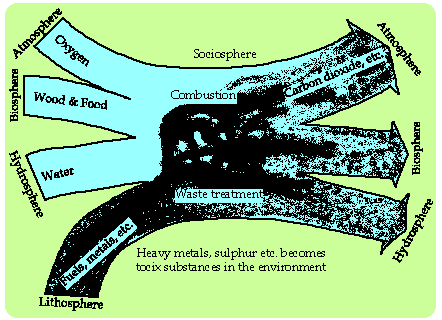
The greatest but least used resource in the society are the human brains, i.e. available intelligence. Lots of assets are usually spent on research and development by a small number of people - the experts. Their opinions, conclusions and decisions are then to be executed by people, who are not supposed to question or oppose the decisions, i.e. central planning and control. The situation is strongly preserved by an educational system, which origins from the Church. The result, however, often turns out differently, since, people by nature think and act themselves. {Squires 1986}
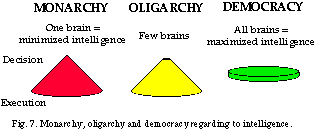
Let us consider three simplified societies: monarchy, oligarchy and democracy. (Fig. 7) Monarchy is characterized by autocracy, where all power and thinking are concentrated to one person - the dictator, who makes all decisions. Thus intelligence is minimized. If the dictator or monarch is replaced by a small number of people we get oligarchy, which characterize today's, so called, democracies. Democracy, which is the exact opposite of monarchy, literally means that everyone takes part in the decisions. Thus, oligarchy is an organization between monarchy and democracy. To call oligarchy democracy is rather an example of the organized hypocrisy, which also characterizes today's, so called, democracies. {Brunsson 1989}
Since the intelligence for two persons is more than for one a democracy is more intelligent than a oligarchy that is more intelligent than a monarchy - variety versus unity. Thus, today's parliaments poorly utilize the available intelligence. Resource depletion and environmental destruction are just symptoms of incompetence and poor management from lack of intelligence. Other symptoms are people's resignation, expressed in lyrics by Cohen {1992}:

Increased competence implies increased intelligence and increased democracy. The awareness of this is growing stronger in industrial management as a tool of increased power of competition. This is one of the major factors behind Japan's economic "miracle". {Womack et al. 1990}
Japanese industry management is not hierarchical as in the West, but flat and has its roots in Eastern philosophy and ideas from American quality pioneers like Deming and Juran. A flat organization practices democracy. (Fig. 7)
W. Edwards Deming states 14 points for management and quality: {Deming 1982}
As we see most of them are obvious and it is remarkable that they need to be stated, but unfortunately they are only rarely practiced within industrial management or elsewhere in the society. All too often you see examples of the opposite, i.e. misuse of people and their intelligence. One of the worst example is war, which characterize so called civilized societies.
Let us also consider some other conclusions from industrial management. {Tribus 1987} (1) "Juran's rule":
|
|
(2) The perversity principle:
|
|
(3) The manager's job has changed:
|
|
These conclusions are just as valid in the rest of the society, especially within education, and not only within industrial management. Thus, a new societal organization should be developed, not to dictate and force people, but instead, to find imperfections in the system with the help of everyone, i.e. democracy. This on the other hand implies a complete change of the educational system, starting already in elementary school. {Pirsig 1974, Tribus et al. 1992}
In short we may say that in industry we re-establish the worker's status and influence over production, and analogously in society we establish democracy.
In Japan these ideas have been practiced and further developed. Today, Japan and the west part of Germany are two of the strongest economies in the world. From, 1945 they have two things in common: (1) defeated and ruined (2) no military arms. The industry was rebuilt from scratch, in Germany with foreign aid, and the military was not allowed to drain neither the economy nor the intelligentsia . One of the more successful Japanese schools is Kaizen, which means gradual, unending improvement, doing "little things" better, setting - and achieving - even-higher standards. "'We call some societies primitive because of their desire to remain in the same state in which gods or ancestors created them at the beginning of time, with a demographic balance which they know how to maintain and an unchanging standard of living protected by their social rules and metaphysical belief.' [Italics added.] It is my sincere hope that we will be able to overcome our 'primitive' state and that the KAIZEN strategy will eventually find application not only in the business community but also in all institutions and societies all over the world." {Imai 1986}
Societal progress should be built on variability - a living organization , as in the living nature - not constancy - a dead organization, dictated and maintained by economy.
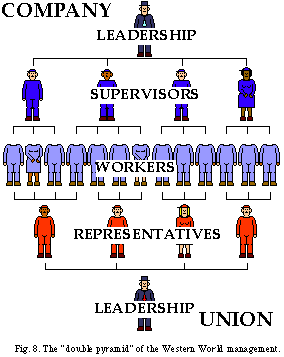
The organization of most Western companies are described in Fig. 8. In the top we have the company's leadership and in the other end we have the union - two poles in a struggle for power, in which the workers and the object of the company often become the losers. Note the missing heads of the workers, since, they are not supposed to make decisions but to follow orders from both opponents. The organization is strongly hierarchic and is based on complete control and obedience.

In Japan, on the other hand, companies often have a flat organization - as a pancake - where the workers and co-workers, i.e. the leadership of the company and the union, work together to satisfy the customer - the object of the business. (Fig. 9) This also maximizes democracy and intelligence. (Fig. 7)
Deming, see above, does not prohibit unions or ask for oppression, he asks for an open dialogue, an influence by workers over production and an organization built on quality - maximal intelligence. Organizations as unions and company leaderships have no ends in themselves, but should be means to maximize the output - the utility of the consumer. The often given advise from Japanese industry leaders to their Western colleagues is to stay more in the factory - the real world - gemba (in Japanese), i.e. to flatten the pyramid or diamond. The production does not take place in the board office but in the factory and by the workers. Similarly the society must be built on democracy, i.e. freedom, intelligence and vitality.
For many Japanese companies the workers are the main capital , they represent the competence, i.e. the intelligence and creativity of the company. Consequently, Japanese companies often have a great diversity of products, i.e. they make better use of their capital. Usually, a daily organized exchange of information occurs within the company and the workers are often offered further education to improve their competence, thus, improving the company's power of competition.
In some Japanese companies the workers are even allowed to make changes in the production themselves. The idea is simply: if the workers act themselves it goes fast and becomes cheap, if the change is to the better it becomes a hit, if it becomes a flop, the workers will be the first to make a new change. In neither case no effort is gained by involving the leadership and the process becomes autonomous and self-developing, just like the evolutionary process in the living nature. This technique is crucial also in a vital society.
The state should stimulate improved exergy efficiency and use of renewable resources. Therefor, all use of deposits - non renewable resources - could be subject to a tax according to the amount of exergy used - a consumption tax. All waste products could also be taxed by the amount of exergy released in the environment, since, this is related to the environmental impact. The exact relation is impossible to find for all substances and all environmental conditions, but, a simple exergy estimation could be one method to tax pollution.
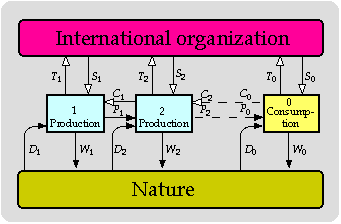
The income from these taxes could be used to support research and other activities to improve exergy efficiency and exergy use. This would influence creativity in the society and establish a closer link between scientific and economic improvements. Since, deposits are subject to taxation this would support the use of natural flows and funds.
From Figs. 4 and 6 we saw how the lack of recycling in the society creates resource depletion and environmental destruction. By an exergy tax according to Fig. 10 this could be changed. This tax could be governed by an international organization, e.g. the United Nations, since the effects usually are global.
Assume a number of producers of goods and services distributed on the market, either for direct consumption or for further production. In Fig. 10 we have producers: 1, 2, etc. and one final consumer: 0, illustrated by numbered boxes. The flows are divided into two categories: (1) solid arrows: physical value and (2) outlined arrows: economical value. They are named accordingly:
Let us first consider the first production process. The company "produces" a physical value P 1 and waste products to the environment W 1, as it consumes deposits D 1. (Since, other flows are omitted we can not apply, nor is there a need for, mass or energy balances of the process.) At the same time, the economical values T 1 and S 1 are exchanged with the international tax-organization. These values have to be covered by the additional cost to the product, C 1, i.e. C 1 = T 1 -S 1. Let us now calculate the exergies of W 1 and D 1 and assign them, ED 1 and EW 1. Assume a tax T 1, which is a function of the exergies, i.e. T 1 (ED 1,EW 1), e.g. a simple summation,
|
|
|
To use exergy as base for the tax has many advantages. (1) The exergy can be calculated from given physical data for the flow and the environment, which could be decided by international agreements. However, small variations in these data has little effect for the exergy value, i.e. the tax. (2) The exergy is related to the usefulness of the extracted deposit, and to its physical (environmental) value, i.e. the physical "cost" to produce the resource from the ambient. (3) Exergy is a measure of the physical value of the environmental stress that is created from the waste products when it ends up as waste in the environment. (4) Exergy is always a positive value when we have a distinction from the natural (reference) environment, see Eq. (1).
Assume a company which uses a large amount of cooling water. The water is taken directly from a river, into the process and brought back downstream. The only thing that happens with the water is a temperature increase by 1K. The conversion of matter and energy might be enormous, maybe thousands of ton and billions of Joule per hour. But, the exergy as well as the stress on the environment is relatively small, thus, the company payees a relatively low tax on its waste flow to the environment. On the other hand, assume a company which emits a small amount of a heavy metal to the environment, maybe some gram per day. The amount of matter and energy is negligible, but the exergy might be considerable if the metal is rare. If the metal represents a large contrast in the environment the company should be taxed accordingly. If the metal is mined by the company this activity is also taxed as a deposit use. These additional charges must be paid for by the market, which than assures a control of its use. One example of the latter is the use of plutonium in the society. Only a few grams can cause a tremendous effect on the environment, which can be related to an enormous exergy content, since plutonium is not a part of a natural environment.
Thus, each good is charged with an extra cost, C 1, from this taxation which goes with the good during its use, all the way to the final consumer, who has to cover the total cost. The producer should be allowed to deduct the exergy tax from its income, in such a way that the tax charges the final consumption. In this way companies which concentrate on resource conservation and environmental protection can be supported by subsidies and loans from the international exergy tax organization.
Since companies and consumers have to pay extra for the use of deposits and for waste products to the environment, other companies may profit from taking care of the waste products at a lower cost than the waste-tax kW 1EW 1. If they succeed in neutralizing the waste products, i.e. decrease the exergy of the waste, they are released from tax. If they manage to convert the waste products to raw material, they might also compete on the market, since they are not subject to any deposit-tax. These companies that convert waste products to resources, act the same way as the decomposer organisms in an ecological system, see Fig. 5, and thus close the material cycles in the society. These "decomposer companies" should also be supported to develop technique to "clean", i.e. wash out toxic substances, as is done in nature. Thus, the exergy tax could be used to support decomposer companies to enter the market.
An exergy tax indirectly support companies based on renewable resources and no harmful waste production, thus, stimulating the development of a vital society.
Exergy is the fuel for dissipative systems, i.e. systems that are sustained by converting energy and matter, e.g. a living cell, an organism, an eco-system, the Earth's surface with its material cycles, or a society. The exergy concept should, therefore, be used systematically to describe such systems scientifically. The environmental problems are mainly consequences from poor resources management, e.g. a too strong belief in traditional engineering and economic growth as the solution. Therefor, we must instead increase the knowledge of the physical resource use in the society, ecology and try to establish a holistic understanding. Ecology should be a part of all education, especially for engineers. The society must establish democracy, i.e. a better utilization of the available intelligence, creativity and plurality. These are necessary steps towards a vital society. Thus, democracy must be learned and practiced and the educational system, from kindergartens to universities, has a major responsibility for this. Teachers should concentrate their efforts more towards teaching the ability to learn, rather than strict behavior. The military era of mankind must come to an end. The human society must become a vital part of the living nature instead of its competitor. This is a must.
Acknowledgment I wish to thank the University of Uppsala, Sweden for the support of this project.
Berman, S. M., et al. (1975) Eds., Efficient Use of Energy , American Institute of Physics Conference Proceedings No. 25.
Brunsson, N., (1989) The Organization of Hypocrisy , Chichester: John Wiley.
Brundtland (1989) Our Common Future, World Commission on Environment and Development , Oxford University Press.
Cohen, L. (1992) The Future (music record), Sony Music Entertainment Inc.
Deming, W. E. (1982) Out of the Crisis - Quality, Productivity and Competitive Position , Cambridge University Press.
Gibbs, J. W. (1873), "A Method of Geometrical Representation of the thermodynamic properties of substances by means of surface." Trans. Conn. Acad. II , 382-404 or The Collected Works , Yale University Press, 1 (1928).
Herendeen, R. (1989) Ecological Modeling , 48 , 19-44.
Imai, M. (1986) Kaizen - The Key to Japan's Competitive Success , McGraw-Hill.
Malaska, P. (1990) "Nature-Oriented Technology", Turku School of Economics and Business Administration, Finland.
Morris, D. R. and Szargut, J. (1986) Energy 11 , 733.
Pirsig, R., (1974) Zen and the Art of Motorcycle Maintenance , New York, Morrow Publisher.
Scheurmann, E. (1920) ed., Der Papalagi - Die Reden des Südsee-Häuptlings Tuiavii aus Tiavea , Felsenverlag, Buchenbach/Baden
Squires, A. M., (1986) The Tender Ship - Governmental Management of Technological Change , Birkhäuser.
Szargut, J. (1985)Bull. Polish Acad. Scie. Tech. Scie. 34 , 475.
Szargut, J., Morris, D. R., and Steward, F. R. (1988) Exergy Analysis of Thermal, Chemical, and Metallurgical Processes , Springer
Tribus, M. (1988) "Deming's Way", Mechanical Engineering, 110 , 26-30.
Tribus, M., Hicks, T., Polk, L. M., Wild, O., (1992) "Simple as A B C", National Forum, British Deming Association, Salisbury, England.
Wall, G. (1977) "Exergy a useful concept within resource accounting", Report No. 77-42, Institute of Theoretical Physics, Göteborg, Sweden.
Wall, G. (1986) "Exergy - a Useful Concept", Thesis, Chalmers Univ. Tech., Göteborg, Sweden.
Wall, G. (1987) "Exergy Conversion in the Swedish Society", RESOURCES and ENERGY , 9 , 55-73.
Wall, G. (1990) "The Exergy Conversion in the Japanese Society", ENERGY 15 , 435-444.
Wall, G., Sciubba, E., Naso, V. (1992) "Exergy Use in the Italian Society", Dipartiment di Meccanica e Aeronautica, Università degli Studi di Roma 'La Sapienza', Rome.
Womack, J. P, Jones, D. T., Roos, D. (1990) The Machine that Changed the World , Macmillan.